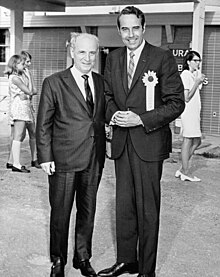Hampar Kelikian
| Hampar Kelikian | |
|---|---|

Kelikian and Bob Dole posing for a picture
|
|
| Born | January 17, 1899 Hadjin, Ottoman Empire |
| Died | July 24, 1983 (aged 84) Chicago, Illinois, United States |
| Nationality |
United States |
| Occupation | Orthopedic Surgeon |
Hampar Kelikian (January 17, 1899 – July 24, 1983) was a maverick orthopedic surgeon, who significantly extended the surgical field.
A pioneer in the restoration of damaged limbs, he was instrumental in helping U.S. Senator Bob Dole. When Dole returned from World War II with injuries that had left his right arm frozen and about to be amputated, Kelikian fixed the shattered shoulder and allowed Dole to regain some use of his arm.
Kelikian was an Armenian orthopedic surgeon and native of Hadjin in the Ottoman Empire. Born Hamparzoum Keklikian, he came to America in 1920 to escape the Armenian Genocide, an event during which his three sisters had been killed. He was inspired to become a surgeon by his uncle, who worked as a physician in the Ottoman army. After emigrating to Chicago in 1920 under the sponsorship of Rev. Antranig A. Bedikian, Kelikian worked as a waiter at the University of Chicago, where he received a scholarship from President Harry Pratt Judson to study there and at Rush Medical College. He finished his internship at Cook County Hospital, and in 1929 became an assistant to Philip Kreuscher, who had been in practice with the bone specialist John Murphy.
During World War II, Kelikian served as chief orthopedic surgeon and lieutenant colonel at the 297th General Hospital. Bob Dole was one of his many patients, and Kelikian refused to accept any fees from the young veteran, since his brother Siragan had been killed in Italy in 1943. In total, Kelikian performed seven operations between 1947 and 1953 to restore the use of Dole's arm by transplanting leg bone and muscle to the right shoulder and hand. He saved the left arm of a young Victor A. Lundy, who would become a leading architect of the Sarasota Modern; Kelikian never discharged his patient, who would serve as his medical artist. Upon his return to Chicago, he joined the staff of Wesley Hospital and Northwestern Medical School.
...
Wikipedia
